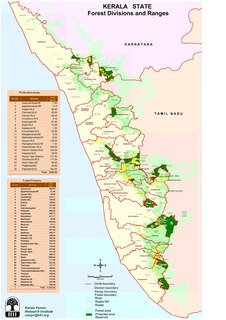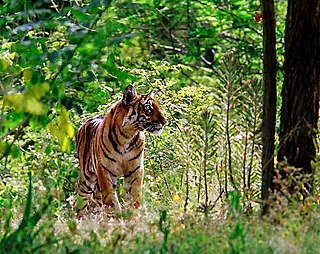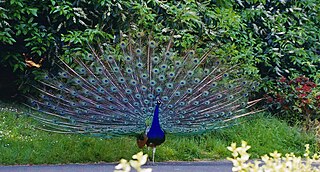
Peafowl is a common name for three bird species in the genera Pavo and Afropavo within the tribe Pavonini of the family Phasianidae, the pheasants and their allies. Male peafowl are referred to as peacocks, and female peafowl are referred to as peahens, even though peafowl of either sex are often referred to colloquially as "peacocks".

The Indian peafowl, also known as the common peafowl, and blue peafowl, is a peafowl species native to the Indian subcontinent. It has been introduced to many other countries. Male peafowl are referred to as peacocks, and female peafowl are referred to as peahens, even though peafowl of either sex are often referred to colloquially as "peacocks".

The green peafowl or Indonesian peafowl is a peafowl species native to the tropical forests of Southeast Asia. It has been listed as endangered on the IUCN Red List since 2009 because the global population has been declining rapidly and is severely fragmented due to loss of habitat.

The Congo peafowl, also known as the African peafowl or mbulu by the Bakôngo, is a species of peafowl native to the Congo Basin. It is one of three peafowl species and the only member of the subfamily Pavoninae native to Africa. It is listed as Vulnerable on the IUCN Red List.

Jaldapara National Park is a national park (2012) (www.jaldaparanationalprk.org) situated at the foothills of the Eastern Himalayas in Alipurduar District of northern West Bengal, India, and on the banks of the Torsa River. Jaldapara is situated at an altitude of 61 m and is spread across 216.51 km2 (83.59 sq mi) of vast grassland with patches of riverine forests. It was declared a sanctuary in 1941 for protection of its great variety of flora and fauna.

Wayanad Wildlife Sanctuary is a wildlife sanctuary in Wayanad, Kerala, India with an extent of 344.44 km2 (132.99 sq mi) and four hill ranges namely Sulthan Bathery, Muthanga, Kurichiat and Tholpetty. A variety of large wild animals such as gaur, Asian elephant, deer and tiger are found there. There are also quite a few unusual birds in the sanctuary. In particular, Indian peafowl tend to be very common in the area. Wayanad Wildlife Sanctuary is the second largest wildlife sanctuary in Kerala. It is bestowed with lush green forests and rich wildlife. This wildlife area houses some of the rare and endangered species of both flora and fauna.

The Idukki Dam is a double curvature Arch dam constructed across the Periyar River in a narrow gorge between two granite hills locally known as Kuravan and Kurathi in Mariyapuram village in Idukki District in Kerala, India. At 168.91 metres (554.2 ft), it is one of the highest arch dams in Asia. It is constructed and owned by the Kerala State Electricity Board. It supports a 780 MW hydroelectric power station in Moolamattom, which started generating power on 4 October 1975. The dam type is a concrete, double curvature parabolic, thin arc dam. The Indo-Canadian project was inaugurated by the Prime Minister Indira Gandhi on February 17, 1976.

Most of Kerala, whose native habitat consists of wet evergreen rainforests at lower elevations and highland deciduous and semi-evergreen forests in the east, is subject to a humid tropical climate. However, significant variations in terrain and elevation have resulted in a land whose biodiversity registers as among the world’s most significant. But the district Alappuzha situated in Kerala is the only district of Kerala which have no forests.

Pavo is a genus of two species in the pheasant family. The two species, along with the Congo peacock, are known as peafowl.

Kottiyoor is a village and Grama Panchayat situated in eastern hilly area of Kannur district in Kerala state. Kottiyoor is the 23rd Wildlife Sanctuary of Kerala, located in the serene hills of Western Ghats. The ancient pilgrimage conducted here yearly, called 'Kottiyoor Vysakha Mahotsavam' attracts thousands of devotees every year. The Vavali river flows through Kottiyoor.

There are more than 2000 species of fauna that can be found in Tamil Nadu. This rich wildlife is attributed to the diverse relief features as well as favorable climate and vegetation in the Indian state.Recognizing the state's role in preserving the current environment, the state government has established several wildlife and bird sanctuaries as well as national parks, which entail stringent protective measures. Tamil Nadu is also included in the International Network of Biosphere Reserves, which facilitates international recognition and additional funding. There are five national parks and 17 sanctuaries that serve as homes to the wildlife.
Morachi Chincholi, by name itself means a village of tamarind trees (Marathi:chincha) and town of dancing peacocks all around. It is situated near Pune-Ahmednagar Highway about 55 km from Pune. Even today one can find a lot of peafowls in the village.

Dalma Wildlife Sanctuary is located 10 km from the city of Jamshedpur in the state of Jharkhand. Inaugurated in 1975 it is a notable wildlife sanctuary and contains significant population of Indian Elephants.

Bankapura Peacock Sanctuary is a wildlife sanctuary inside the Bankapura Fort in Haveri District, Karnataka, India.

The peacock dance or peafowl dance is a traditional Asian folk dance that describes the beauty and the movement of peacocks. There are several peacock dance traditions developed in Asia, among others are peacock dances of Myanmar, and in the western and northern parts of Cambodia, West Java in Indonesia, also peacock dances of Indian subcontinent in Southern India, Sri Lanka, and Bangladesh.
Peacock & Chinkara Breeding Centre, Jhabuwa is a 750-acre protected peacock and chinkara reserve forest in Jhabuwa village 15 km south of Bawal in Rewari district in the Indian state of Haryana. Jhabuwa is 100 kilometres (62 mi) from Delhi and 70 kilometres (43 mi) from Gurugram and 200 km from Hisar.

Chapparapadavu is a Grama panchayat in Kannur district in the Indian state of Kerala. Chapparapadavu Panchayat have administration over the villages of Kooveri, Thimiri, and Vellad.
Pyin-O-Lwin Bird Sanctuary is a protected area in Myanmar's Pyinoolwin Township in Mandalay Region covering an area of 127.25 km2 (49.13 sq mi). It was gazetted in 1918 and spans an elevation of 975–1,210 m (3,199–3,970 ft). It is one of four protected wetlands.

Idukki Wildlife Sanctuary is Wildlife Sanctuary located in Idukki district of Kerala, India. Situated around the catchment area of Idukki Dam, the Idukki Wildlife Sanctuary is rich in biodiversity and rich flora and fauna.

Choolannur Pea Fowl Sanctuary is a bird sanctuary located in Chulanur village in Palakkad district of Kerala state, south India. The place where sanctuary is located is locally known as Mayiladumpara which literally means 'the rock where peacocks dance'. At present (2022) it is the only Pea fowl sanctuary in Kerala.


















